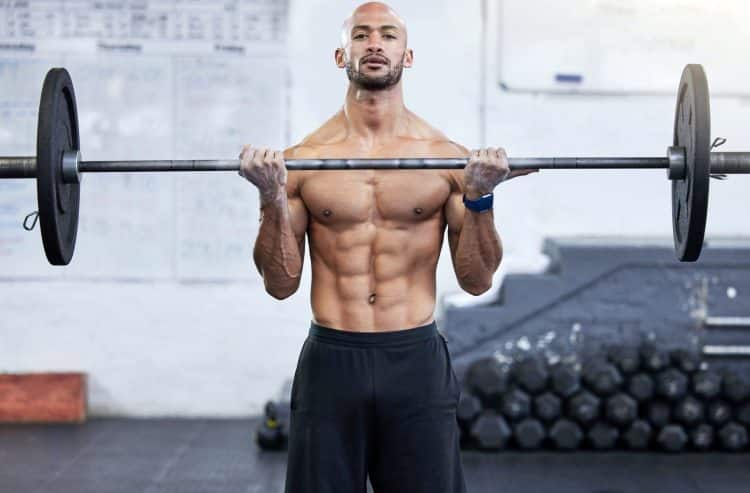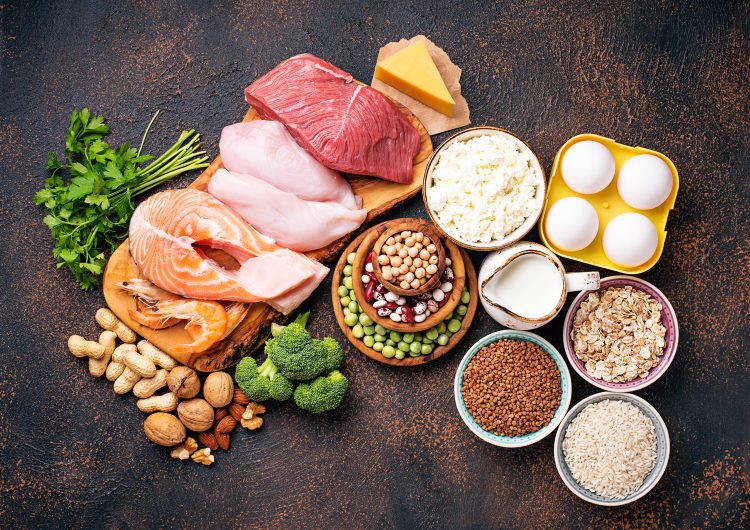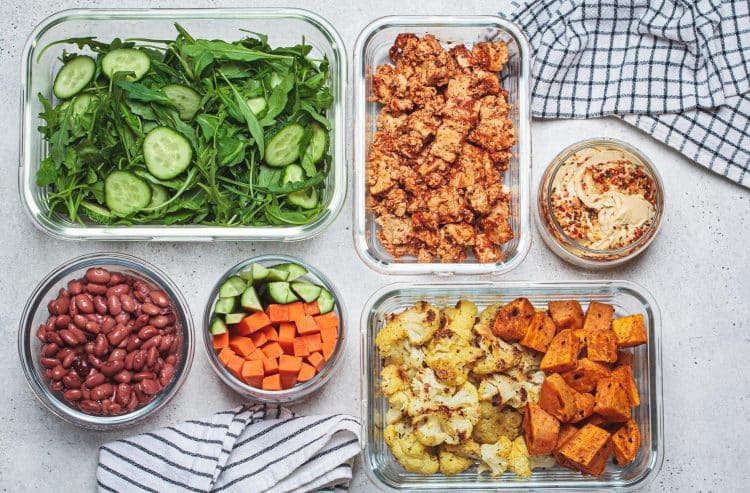Every now and then, a trendy new catchphrase enters the fitness world. Often it’s nothing more than an old concept repackaged for a new generation.
Recently the word ‘maingaining’ has been gaining traction among gymgoers.
Maybe you’ve heard it and wondered what it’s all about.
Let’s explore the maingaining concept to see whether it can help you create a leaner, more muscular physique.
What is Maingaining?

Maingaining refers to the practice of slowly building muscle while maintaining your current level of body fat. This contrasts with the bulking and cutting system, where you eat way above your calorie maintenance level for a prolonged period, inevitably gaining fat along with muscle. You then go on a cutting diet to lose fat.
Level Up Your Fitness: Join our 💪 strong community in Fitness Volt Newsletter. Get daily inspiration, expert-backed workouts, nutrition tips, the latest in strength sports, and the support you need to reach your goals. Subscribe for free!
With maingaining, you only consume a few more calories than your maintenance level, aiming to gradually increase your lean body mass without adding fat weight.
While some people use the maingaining concept long term, others use it as a transition between their bulking and cutting cycles.
Does Building Muscle Require a Caloric Surplus?
A key difference between the maingaining and the traditional bulking diet is that you do not create a large caloric surplus to build muscle in the latter approach. Yet, the traditional bodybuilding wisdom has been that a caloric surplus is essential for muscle gain.
So, what’s the truth here?
Building muscle requires a caloric surplus, meaning you need to consume more calories than you burn to provide your body with the energy it needs to build new muscle tissue. This surplus energy helps fuel the muscle protein synthesis process necessary for muscle growth.
However, it is important to note that the caloric surplus does not need to be excessive and that a moderate surplus combined with regular strength training is usually sufficient for most people to build muscle.
A 2013 study showed that people who consumed 600 calories above their maintenance level did not gain much more muscle than those who ate only an extra 100 calories. However, they did gain significantly more body fat. [1]
There are other factors influencing your ability to gain muscle with just a moderate caloric increase above your maintenance level.
People new to weight training will have an easier time gaining muscle without significantly increasing their food intake than people who have been working out for years.
If you have previously built muscle mass but then lost it, you can regain that muscle without eating a lot more than your body needs to meet its energy demands. This is a result of the phenomenon known as ‘muscle memory.’
Maingaining has become a popular muscle-building method recently. Here’s why so many people opt for maingaining rather than the traditional bulk and cut method:
- They don’t want to deal with the uncomfortable nature of eating large amounts of food daily during bulking and then depriving themselves during the cutting phase.
- These folks have already built a decent amount of mass and now want to add extra muscle slowly.
- They want to maintain a healthy year-round leanness rather than experiencing yo-yo body weight changes.
Who is Maingaining Ideal For?
Maingaining is ideally suited for people wanting to add modest amounts of muscle, gradually increasing their lean body mass. The following groups are best suited to maingaining:
Beginners
Beginner trainers are best suited to this method. Beginners experience “newbie gains,” which refers to the rapid initial improvements in muscle size and strength that can occur in the first few months of training. This can be due to a combination of factors, such as improved neuromuscular coordination, increased protein synthesis, and better recovery from training.
Those Who are Rebuilding Muscle
People who have lost some muscle size due to a lay-off will also benefit from following a maingaining method. The body has a type of muscle memory, which means that it can more easily rebuild lost muscle, even if it has been lost due to a period of detraining or inactivity. This is because the neural pathways previously established to activate the muscle fibers are still present and can be reactivated with training.
Muscles that have been trained and then lost tend to have more nuclei than untrained muscles, which may allow for more rapid muscle protein synthesis and greater muscle growth upon retraining.
People who have lost muscle mass may also experience an increase in muscle protein synthesis due to a phenomenon known as the “repeated bout effect,” which refers to the body’s increased ability to adapt to a stimulus that it has previously encountered.
People With High Fat Levels
Folks with high-fat levels already have a lot of stored energy in their bodies. This means that they are in a better position to gain muscle without consuming extra calories to meet their energy needs.
For those with high body fat levels, creating a small caloric deficit may be possible while still building muscle. However, this requires careful attention to nutrition and a well-designed training program that emphasizes progressive overload and muscle hypertrophy.
People Who Want to Maintain Rather than Build
People happy with their current level of muscle mass can maintain their gains by training regularly. Because they aren’t trying to add new muscle, they do not have to increase their caloric intake.
Who Will Not Benefit From Maingaining?
Maingaining will result in modest muscle gains. This will not be the best approach for the following groups:
Hardgainers
“Hard gainer” is a term used to describe someone who has difficulty building muscle mass, despite engaging in regular weight training and consuming sufficient calories and protein. This may be due to several factors, such as a faster metabolism, a smaller appetite, or a genetic predisposition towards lower muscle mass.
To build muscle as a hard gainer, focusing on significantly increasing your overall calorie intake and paying special attention to consuming enough protein to support muscle growth is important. This may mean eating more frequently, consuming protein-rich foods like lean meats, eggs, and dairy products, and using protein supplements if needed.
People Who Want to Gain Max Muscle Fast
Increasing caloric intake by 500 calories or more is typically advised to maximize muscle development. This is because constructing muscle takes energy, and consuming more calories than the body expends (a condition known as a caloric surplus) can supply the additional energy required to promote the synthesis and repair of muscle protein.
How Does Traditional Bulking and Cutting Work?
Traditional bulking and cutting for muscle gain is a dietary strategy that involves alternating between periods of calorie surplus (bulking) and calorie deficit (cutting). The goal of the bulking phase is to consume more calories than the body burns to provide the extra energy needed to support muscle protein synthesis and growth while minimizing fat gain. This typically involves consuming an excess of around 10-20% above maintenance level and a higher intake of protein and carbohydrates to support muscle growth.
Level Up Your Fitness: Join our 💪 strong community in Fitness Volt Newsletter. Get daily inspiration, expert-backed workouts, nutrition tips, the latest in strength sports, and the support you need to reach your goals. Subscribe for free!
Once the bulking phase is complete, the cutting phase is initiated. During the cutting phase, calorie intake is reduced to below maintenance level to promote fat loss while preserving muscle mass. This typically involves a caloric deficit of around 20-25% below maintenance level while maintaining a high protein intake to prevent muscle loss.
Bodybuilders and other athletes often use the traditional cutting and bulking approach to maximize muscle gains while minimizing fat gain.
Pros and Cons of Bulking and Cutting
Here are the advantages and disadvantages of using the bulking and cutting phases:
Pros:
- More energy for muscle growth is possible when you consume more calories than you require during the bulking period.
- More energy for training. The additional energy from a bulking phase can also increase energy for training, enabling more strenuous sessions.
- Dieting can be more enjoyable for individuals who appreciate food. The bulking phase allows you to consume a larger variety of foods and more calories.
Cons:
- One of the major drawbacks of the bulking phase is the potential for fat gain, which can be challenging to shed during the cutting phase.
- Tracking calorie intake is challenging. It can be challenging to correctly track calories consumed during a bulking phase, resulting in overeating and excessive fat accumulation.
- Risk for muscle loss during the reducing phase. If the cutting phase’s calorie deficit is too significant, there is a chance of losing muscle, which might counteract any increases acquired during the bulking phase.
- Mental exhaustion: For some people, the continual emphasis on diet and the frequent adjustments to caloric intake and macronutrient ratios can be mentally draining.
How to Find Your Maintenance Level
Both maingaining and bulking and cutting revolve around your caloric maintenance level. With maingaining you either stick to your maintenance level or eat just slightly above it. Bulking and cutting involve eating 10-20 above and then up to 25% below your maintenance level.
So, how do you find your maintenance level?
There are several methods to estimate your maintenance level. Still, one simple way is to use an online calculator or formula that considers your age, gender, weight, height, and activity level.
The most common formula used to estimate maintenance level is the Harris-Benedict equation.
Here is the formula for men and women:
- Men: BMR = 88.362 + (13.397 x weight in kg) + (4.799 x height in cm) – (5.677 x age in years)
- Women: BMR = 447.593 + (9.247 x weight in kg) + (3.098 x height in cm) – (4.330 x age in years)
Once you have calculated your basal metabolic rate (BMR), the number of calories your body burns at rest, you can multiply it by an activity factor to estimate your maintenance level. Here are some common activity factors:
- Sedentary (little or no exercise) = 1.2
- Lightly active (1-3 days of exercise per week) = 1.375
- Moderately active (3-5 days of exercise per week) = 1.55
- Very active (6-7 days of exercise per week) = 1.725
- Extra active (very intense exercise or physical job) = 1.9
- For example, if your BMR is 1,800 calories and you are moderately active, you would multiply 1,800 by 1.55 to get an estimated maintenance level of 2,790 calories.
Here’s an example of how you could use the Harris-Benedict equation to calculate your caloric maintenance level:
Let’s say you are a 35-year-old man, weighing 80 kilograms (176 pounds) and standing at 1.80m (180cm) tall:
BMR = 88.362 + (13.397 x 80) + (4.799 x 180) – (5.677 x 35) = 88.362 + 1071.76 + 863.2 – 197.945 = 1825.287
Let’s say you have a moderately active lifestyle (activity factor = 1.55).
TDEE = BMR x 1.55 = 1825.287 x 1.55 = 2817.942
So, in this example, the caloric maintenance level for this 35-year-old man weighing 80 kilograms and standing at 1.80m (180cm) tall would be around 2,818 calories per day.
Related:
- TDEE Calculator: Find your Total Daily Energy Expenditure, Maintenance, Cutting and Bulking.
- Leangains Calculator for Lean Bulk or Cutting.
- BMR Calculator: Find Your Basal Metabolic Rate.
- Sitting vs. Standing Calories Burned Calculator.
- AMR Calculator for Active Metabolic Rate.
Can You Build Muscle and Lose Fat at the Same Time?
It is possible to build muscle and lose fat simultaneously, although it can be challenging and require a more individualized approach to nutrition and training. This is known as body recomposition, which involves increasing muscle mass while reducing body fat. The key to body recomposition is creating a small caloric deficit while providing enough energy and nutrients to support muscle growth.
Here are some strategies that may help with body recomposition:
- Resistance training: Focus on strength training and hypertrophy exercises to stimulate muscle growth.
- Higher protein intake: Consuming a higher protein intake, around 1-1.5 grams of protein per pound of body weight, can help support muscle growth and repair.
- Caloric deficit: Create a small caloric deficit of 250-500 calories per day by reducing overall calorie intake, increasing activity levels, or a combination of both.
- Cardiovascular exercise: Incorporate cardiovascular exercise into your routine to help increase calorie burn and promote fat loss.
- Rest and recovery: Adequate rest and recovery are critical for muscle growth, and hard gainers may need to pay special attention to getting enough sleep, minimizing stress, and taking rest days between workouts.
People with high body fat percentages (20% or higher) can build muscle and lose fat simultaneously without increasing or decreasing their calorie intake. Building muscle requires a certain amount of energy, which can come from stored body fat.
Provided that you are getting plenty of protein through your diet and are training hard in the gym, you can add lean muscle mass while also burning off calories to bring down your body fat levels.
Read also: Body Recomposition – How to Lose Fat and Gain Muscle
Meeting your Protein Requirements for Muscle Gain

Your ability to add muscle depends on eating high-quality protein, whether you go for a maingaining or a bulking and cutting strategy.
Muscle tissue’s main building material is protein. Intense resistance exercise causes minute tears in the muscle tissue. The body subsequently repairs them with the help of protein-derived amino acids. So, getting enough protein is essential for promoting muscle growth.
For most people, daily protein needs to be in the range of 1.1–1.5 grams per pound of body weight.
It’s important to consider the quality of the protein you eat and the quantity. The body needs all nine essential amino acids to maintain muscle growth and repair, and these amino acids can only be found in high-quality proteins, such as those found in animal products.
Lean meats, eggs, dairy products, lentils, and protein supplements like whey protein powder are all examples of excellent whole-food sources of protein.
Plant-based proteins, such as those in grains, legumes, and nuts, can also be a healthy source of protein, but it might be necessary to combine different sources to get all of the necessary amino acids.
Last but not least, the time of your protein consumption can impact how much muscle you gain. You should take protein in the 30 to 60 minutes following your workout to stimulate muscle growth and repair.
Related:
- How Much Protein To Gain Muscle?
- Protein Calculator: Find Your Daily Protein Intake.
- Best Low Calorie Protein Powders.
- Our List of 40 Great Protein-Packed Foods.
Maingaining: The Bottom Line
Maintaining involves eating at or just slightly above your caloric maintenance level while training hard in the gym. The goal is to gradually increase your lean muscle mass while maintaining your body fat level. This method is best suited for beginners, people coming back to training after a lay-off, and those wanting to maintain rather than pack on new muscle.
If you are a hard gainer or simply want to gain maximum muscle mass in the shortest amount of time, then maingaining is not for you. Your body needs extra calories to build serious muscle, so you’ll have to add 250-500 calories daily to provide them. Combine that extra caloric intake with hard, heavy training, get plenty of rest, and you’ll get the results you’re after.
References
- Garthe I, Raastad T, Refsnes PE, Sundgot-Borgen J. Effect of nutritional intervention on body composition and performance in elite athletes. Eur J Sport Sci. 2013;13(3):295-303. doi: 10.1080/17461391.2011.643923. Epub 2012 Mar 1. PMID: 23679146.













